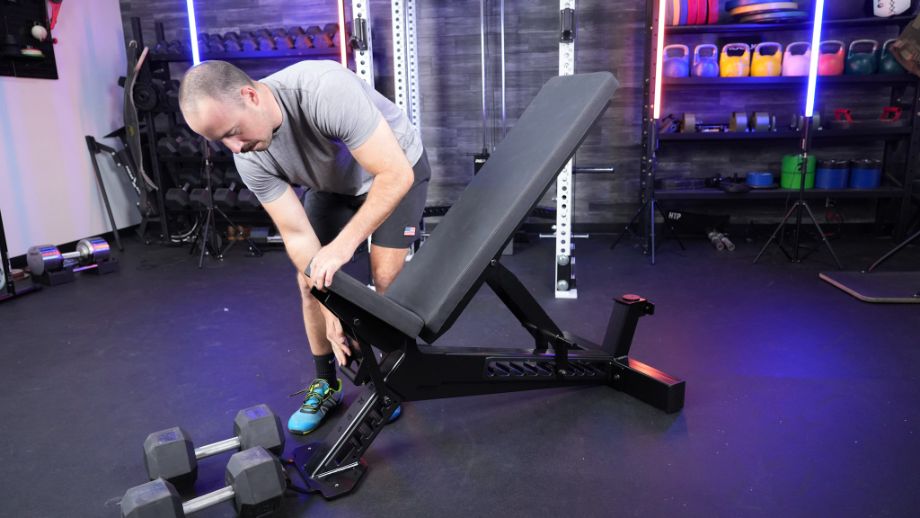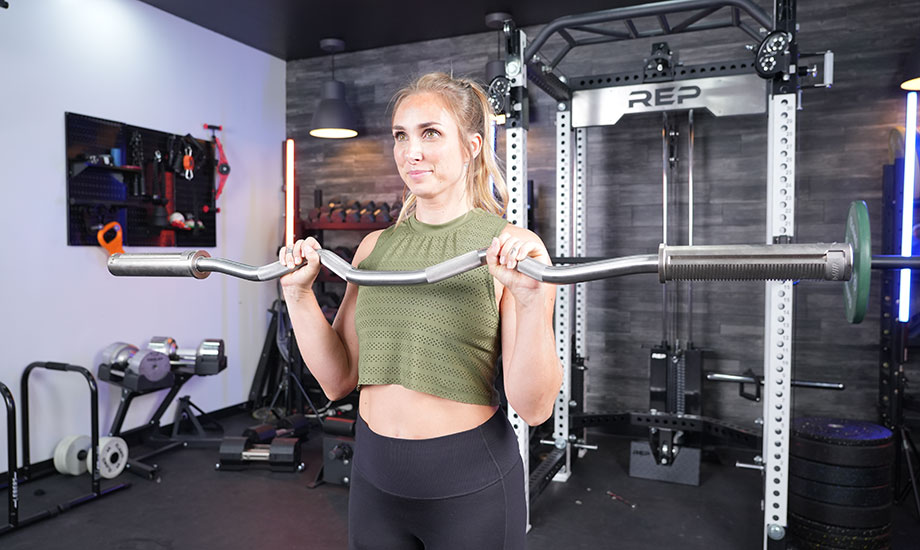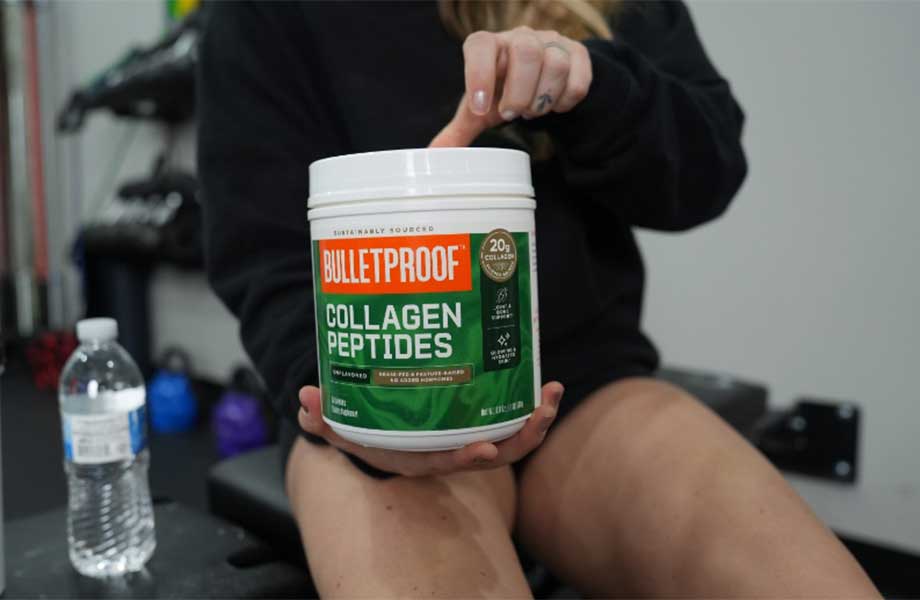Spider-Man does whatever a spider can, but can he do spider curls?
The spider curl is a supremely underrated biceps exercise that involves lying prone—typically against an incline bench—and curling free weights to isolate the short head from the long head of the biceps more effectively. If building bigger biceps is one of your goals, exercises like the spider curl, concentration curl, and other bicep curl variations make a practical addition to your regular arm workout routine.
RELATED: How to Gain Arm Mass
Kate Meier, NASM-CPT, USAW-L1, CF-L1, and GGR head of content/superhero, has the scoop on this amazing biceps exercise, providing step-by-step instructions on how to do spider curls with proper form, spider curl benefits, alternatives, variations, and more. Check it out below!
RELATED: Superhero Workout
How to Do the Spider Curl
Muscles worked: Biceps brachii, triceps brachii, brachialis, forearms
How to do it:
- Set an incline bench to a 45-degree angle, get into a prone position by pushing your upper chest and shoulders into the backpad (with your head peeking over the top), and hold your barbell (or dumbbells) using a shoulder-width supinated (palms facing up) grip.
- Keeping your chest and upper arms stationary, bend your elbows to curl the weight toward your shoulders. Pause and squeeze your biceps at the top of the movement.
- Slowly extend your elbows to return to the starting position.
- Reset and repeat for reps
RELATED: Best Curl Bars

Trainer Tips for Form
When performed correctly, the spider curl ranks among the best exercises to include in your biceps workout—we’ll explain why further down. Here are a few pointers to help you ace the form.
Think Slow, Steady, and Stationary
Have you ever spied a stereotypical gym-bro rocking his entire body back and forth to blast through rapid fire biceps curl reps? Biceps curls are supposed to be an isolation exercise, not a full-body movement.
“Spider curls eliminate your ability to cheat reps by anchoring your upper body to the bench,” says Kate Meier, NASM-CPT, USAW-L1, CF-L1. “Stuck in that stationary position, you’re able to more effectively isolate the muscle groups you’re supposed to be using to get the job done— the biceps, of course!”
Taking your time also ensures you’ll promote optimal muscle growth, as this maximizes your muscle’s time under tension. That’s especially important for the eccentric phase of the lift, as studies show1 that eccentric contractions provide greater gains than concentric contractions.
Get the Right Angle
“Anywhere between 30 and 60 degrees of incline works well to get the right positioning,” says Kate. “We teach 45 degrees because it’s a happy medium, but you can implement more incline for a greater range of motion as you progress.”
Don’t be afraid to try different angles between 30 and 60 degrees, as a 45-degree angle may not be feasible for taller lifters with long arms. Going too low may place undue stress on your shoulder joints, increasing your risk of injury.

Look for that sweet spot and stick to it. If you have any trouble finding where that may be for you, consider working with a certified personal trainer or other qualified fitness professional.
Protect Ya Neck
Wu-Tang Clan probably weren’t talking about spider curls with their ’93 hit single “Protect Ya Neck,” but you’ll want to protect your neck regardless.
If you have the correct positioning, your upper chest will be pressed into the bench’s back support, leaving your head essentially free floating just above. That’s fine, but you’ll by no means want to keep it on a swivel while you’re working through your sets.
“Our muscles are under tension when we lift, so moving your head and neck during a set of spider curls could inadvertently lead to a neck injury,” says Kate. “Tucking your chin to your chest helps stabilize the head and neck, protecting this vital area from injury.”
Whether you’re working with heavy weights or going light to learn the form, tuck your chin as you get into position so you know your head and neck are protected.
Spider Curl Benefits
Between barbell curls, hammer curls, preacher, and concentration curls, there’s certainly no shortage of bicep curl exercises. So, what makes the spider curl so special?
Greater Isolation of the Biceps Muscle
Your regular tried-and-true biceps curl is already categorized as an isolation exercise since, when performed properly, the biceps brachii bears the brunt of the workload. However, doing curls while standing requires other muscle groups to contribute to maintain a strong, stable posture. Sitting down helps remedy this to some degree, but it’s still not true isolation.
The spider curl—since you’re stabilized against the bench—is similar to the preacher curl and concentration curl in the level of isolation you’re able to achieve. Few other biceps exercises produce the same level of activation in the short head of the bicep as the spider curl, making it a no-brainer move for strength athletes, bodybuilding competitors, and just about anyone in the market for bigger biceps.
RELATED: Bodybuilding Workouts
Full Range of Motion
We mentioned concentration and preacher curls as alternatives to the spider curl, and while they are very useful in their own right, the spider curl has one big advantage over them: the range of motion.

RELATED: Best Biceps Workout
“Because the setup of the spider curl involves your arms dangling, fully extended, towards the floor rather than being braced by your thigh or the preacher bench,” says Kate, “you will get a larger range of motion and, therefore, perform more work on each rep, comparatively.”
Increased Time Under Tension
According to the International Journal of Environmental Research and Public Health2, subjecting your muscles to more time under tension (TUT) should contribute to greater muscle hypertrophy.
Your arms aren’t being stabilized by your body (or a preacher bench) at any point during the spider curl movement pattern, so your biceps brachii are experiencing constant tension until you place your weights down. This helps make each rep more effective by maximizing the time under tension, helping you get more work done in less time.
How to Program the Spider Curl
Where can spider curls fit into your workout routine?
“Spider curls make an intuitive addition to various workout splits,” says Kate Meier, NASM-CPT, USAW-L1, CF-L1. “You could work them into a day completely dedicated to biceps. Biceps pair nicely with triceps exercises and back exercises, too.”
The number of sets, rep scheme, and amount of rest recommended varies depending on your personal goals. Here are some recommendations on what to add based on your goals.
| Goal | Sets | Reps | Weight | Rest |
| Strength | 2–6 | 1–5 | 80% 1RM | 2–3 minutes |
| Hypertrophy | 3–6 | 6–12 | 60–75% 1RM | 60 seconds |
| Endurance | 2–3 | 15–20 | 40% 1RM | 60 seconds |
RELATED: How Many Reps To Build Muscle
Common Spider Curl Mistakes
Knowing the proper set-up and technique doesn’t mean you’re immune to making form mistakes. Here are some of the most common mistakes to look out for on the spider curl.
Using Momentum
Listen—you’ll have your upper body pinned to a bench, making it much harder to swing your torso and generate momentum to help you cheat. However, your arms are free, meaning you’ll need to exercise some control here for strict reps.
“It’s easy, especially as your muscles start fatiguing, to flub the eccentric phase and let gravity take over,” says Kate. “Letting your arm fall back down by itself not only deprives you of that all-important eccentric muscle contraction, but it also means your arms will start swinging and inadvertently help you cheat the next rep.”

RELATED: Eccentric Training
To avoid this, move slowly and with control through the concentric and eccentric phases of the exercise. Squeeze your biceps at the top, and come to a full stop between reps.
Going Too Heavy
Are you used to repping a lot of weight when doing standing barbell curls? You may not be as deadly on the spider curl, and that’s okay! It’s an intermediate level movement that requires poise and technique to execute, especially when it comes to lifting heavy ass weight. Sloppy form may lead to an injury if you try going as heavy as possible. Instead, start light and scale gradually.
You may be surprised by the difference in what you’re able to spider curl compared to a standard curl, but don’t let it throw you for a loop. The increased muscle activation will more than make up for the drop in the amount of weight you’re lifting.
Spider Curl Variations/Alternatives
An Olympic barbell or EZ-bar aren’t the only ways to get in your spider curl reps. Here are a few variations and alternatives (complete with tutorials) to keep your workout routine varied.
Dumbbell Spider Curl
Why do it: “Bilateral exercises help us save time by working both sides simultaneously, but our stronger side often compensates for the weaker side as the muscles fatigue,” says Kate Meier, NASM-CPT, USAW-L1, CF-L1. “Performing spider curls as a unilateral exercise or by using dumbbells helps correct these bilateral deficits and muscle imbalances.”
How to do it:
- Grab a pair of dumbbells and set them on the floor behind an incline bench.
- Set the incline bench to a 45-degree angle, then sit down, push your chest into the backpad, and pick up your dumbbells with your palms facing up.
- Keeping your chest and upper arms stationary, bend your elbows to curl the weights toward your shoulders. Pause and squeeze your biceps at the top of the movement.
- Slowly extend your elbows to return to the starting position.
- Repeat for reps.
RELATED: Best Dumbbells

Reverse Spider Curl
Why do it: According to Peer J3, performing bicep curls and curl variations with a reverse grip increases muscle activation in the brachioradialis, a forearm muscle that assists wrist extension.
How to do it:
- Load your barbell and setup as you would for the regular spider curl. Once in position, reach down and, instead, grip the bar with an overhand grip rather than underhand.
- Bend your elbows to curl the bar to your shoulders.
- Squeeze your biceps, then slowly straighten your arms to return to the starting position.
- Repeat for reps.

Preacher Curl
Why do it: Preacher curls aren’t just great for isolating the biceps muscle; the preacher bench stabilizes your elbow joint, providing support as you scale to heavier and heavier weights.
How to do it:
- Adjust the preacher bench to your preference, then sit down.
- Drape your arms over the preacher pad so that your elbows are firmly against the support. Hold your choice of free weights against the pad with arms fully extended.
- Curl the bar to your shoulders, keeping your upper arms and elbows against the pad.
- Squeeze your biceps at the top, then lower the weights back down.
- Repeat for reps.
RELATED: Best Biceps Workout

Cable Curl
Why do it: According to the American Council of Exercise4, the cable curl ranks among the best exercises in regards to biceps brachii activation. Plus, the constant tension provided by the cable machine offers a new stimulus to help you keep your routine fresh and break plateaus.
How to do it:
- Set your cable machine pulley to the lowest position, attach a straight bar, and stand facing the machine with your feet shoulder-width apart.
- Grab the bar using an underhand grip.
- Keeping your elbows pinned to your torso, slowly curl the bar to your shoulders.
- Squeeze the contraction, then slowly lower the bar back down to the starting position.
- Repeat for reps.
RELATED: Cable Arm Workouts

Zottman Curl
Why do it: The Zottman curl is your basic biceps curl with a twist, as in you literally twist your forearms at the top to increase the activation to your biceps, forearm flexors, and forearm extensors. That should help you build big biceps and develop great grip strength too!
How to do it:
- Stand with your chest tall, back straight, core braced, and feet shoulder-width apart.
- Hold a pair of dumbbells in front of your body with your palms facing forward.
- Curl the dumbbells to your shoulders, squeezing your biceps at the top.
- Rotate your lower arms so that your palms now face away from your face.
- Slowly lower the dumbbells back to the starting position.
- Twist again so your palms face forward again.
- Repeat for reps.

Spider Curl: FAQs
What are spider curls good for?
Spider curls rank among the best isolation exercises for your biceps muscles. Spider curls should also help you build bigger biceps when combined with standard biceps curls, curl variations, and a well-rounded diet (the best supplements for muscle growth don’t hurt either).
Are spider curls better than bicep curls?
“Standard bicep curls are great for targeting and building the biceps, but performing them from a standing position ropes in other muscle groups and takes some of the emphasis off of the biceps,” says Kate Meier, NASM-CPT, USAW-L1, CF-L1, and GGR head of content. “In that regard, spider curls may be more effective than bicep curls.”
Are spider curls 30 or 45 degrees?
Spider curls can be performed with an incline bench set anywhere between 30 and 60 degrees, but 45 degrees tends to work for most people. Don’t be afraid to adjust the angle when getting acquainted with the spider curl, and if/when in doubt, consult a personal trainer.
RELATED: Best Weight Bench
What is a good weight for spider curls?
Because of the unique positioning, you likely won’t be able to move as much weight on the spider curl as on the regular bicep curl. To maintain a low risk of injury, start light and scale gradually.
Ideally, you’ll want to move a weight that allows you to maintain form for every rep, and the last one or two reps should feel challenging. If your form is breaking down too early, switch to lighter weights and renew your form focus. Always prioritize form over lifting heavier.
References
1. Sato S, Yoshida R, Murakoshi F, et al. Comparison between concentric-only, eccentric-only, and concentric-eccentric resistance training of the elbow flexors for their effects on muscle strength and hypertrophy. Eur J Appl Physiol. 2022;122(12):2607-2614. doi:10.1007/s00421-022-05035-w
2. Krzysztofik M, Wilk M, Wojdała G, Gołaś A. Maximizing Muscle Hypertrophy: A Systematic Review of Advanced Resistance Training Techniques and Methods. Int J Environ Res Public Health. 2019;16(24):4897. Published 2019 Dec 4. doi:10.3390/ijerph16244897
3. Marcolin G, Panizzolo FA, Petrone N, et al. Differences in electromyographic activity of biceps brachii and brachioradialis while performing three variants of curl. PeerJ. 2018;6:e5165. Published 2018 Jul 13. doi:10.7717/peerj.5165
4. Young, M.S., S., Porcari, Ph.D., J. P., Camic, Ph.D., C., Kovacs, Ph.D., A.; Foster, Ph.D., C. Ace Study Reveals Best Biceps Exercises. ACE. ProSource™: August 2014






